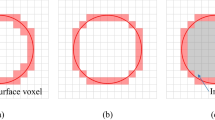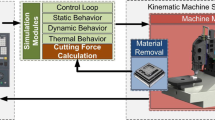Abstract
A new digital-based model is presented for the prediction of cutting forces in 3-axis CNC milling of surfaces. The model uses an algorithm to detect the work-piece/cutter intersection domain automatically for given cutter location, cutter and work-piece geometries. The algorithm uses a voxel-based representation for the workpiece and rasterized tool slice to detect the tool engagement. Furthermore, an analytical approach is used to calculate the cutting forces based on the discretized model. The results of model validation experiments on machining PMMA, Aluminum 6061 and 304 Stainless Steel are presented. Comparisons of the predicted and measured forces show that this digital approach can be used to accurately predict forces during machining.


















Similar content being viewed by others
References
Altintas, Y. (2012). Manufacturing automation: Metal cutting mechanics, machine tool vibrations, and CNC design. Cambridge: Cambridge University Press.
Balabokhin, A., & Tarbutton, J. (2017). Automatic generalized cutter selection for finishing of free-form surfaces in 3-axis CNC milling by surface tolerance and tool performance metrics. The International Journal of Advanced Manufacturing Technology, 93(1–4), 423–432. https://doi.org/10.1007/s00170-017-9986-9.
Boz, Y., Erdim, H., & Lazoglu, I. (2011). Modeling cutting forces for five axis milling of sculptured surfaces. Advanced Materials Research, 223, 701–712. https://doi.org/10.4028/www.scientific.net/AMR.223.701.
Engin, S., & Altintas, Y. (1998). Generalized modeling of milling mechanics and dynamics: Part I—Helical end mills. American Society of Mechanical Engineers Manufacturing Engineering Division MED, 10(1997), 345–352.
Fussell, B. K., Jerard, R. B., & Hemmett, J. G. (2003). Modeling of cutting geometry and forces for 5-axis sculptured surface machining. Computer-Aided Design, 35(4), 333–346. https://doi.org/10.1016/S0010-4485(02)00055-6.
Kilic, Z. M., & Altintas, Y. (2016a). Generalized mechanics and dynamics of metal cutting operations for unified simulations. International Journal of Machine Tools and Manufacture, 104, 1–13. https://doi.org/10.1016/j.ijmachtools.2016.01.006.
Kilic, Z. M., & Altintas, Y. (2016b). Generalized modelling of cutting tool geometries for unified process simulation. International Journal of Machine Tools and Manufacture, 104, 14–25. https://doi.org/10.1016/j.ijmachtools.2016.01.007.
Lee, P., & Altintaş, Y. (1996). Prediction of ball-end milling forces from orthogonal cutting data. International Journal of Machine Tools and Manufacture, 36(9), 1059–1072. https://doi.org/10.1016/0890-6955(95)00081-X.
Manav, C., Bank, H. S., & Lazoglu, I. (2013). Intelligent toolpath selection via multi-criteria optimization in complex sculptured surface milling. Journal of Intelligent Manufacturing, 24(2), 349–355. https://doi.org/10.1007/s10845-011-0596-3.
Markopoulos, A. P., Manolakos, D. E., & Vaxevanidis, N. M. (2008). Artificial neural network models for the prediction of surface roughness in electrical discharge machining. Journal of Intelligent Manufacturing, 19(3), 283–292. https://doi.org/10.1007/s10845-008-0081-9.
Ramaraj, T. C., & Eleftheriou, E. (1994). Analysis of the mechanics of machining with tapered end milling cutters. Journal of Engineering for Industry, 116(3), 398. https://doi.org/10.1115/1.2901958.
Schmitz, T. L., & Smith, K. S. (2008). Machining dynamics: Frequency response to improved productivity. Berlin: Springer.
Sharma, V. S., Dhiman, S., Sehgal, R., & Sharma, S. K. (2008). Estimation of cutting forces and surface roughness for hard turning using neural networks. Journal of Intelligent Manufacturing, 19(4), 473–483. https://doi.org/10.1007/s10845-008-0097-1.
Tarbutton, J. A., Kurfess, T. R., & Tucker, T. M. (2013b). Graphics based path planning for multi-axis machine tools. Computer-Aided Design and Applications, 7(6), 835–845. https://doi.org/10.3722/cadaps.2010.835-845.
Tarbutton, J., Kurfess, T. R., Tucker, T., & Konobrytskyi, D. (2013a). Gouge-free voxel-based machining for parallel processors. The International Journal of Advanced Manufacturing Technology, 69(9–12), 1941–1953. https://doi.org/10.1007/s00170-013-5148-x.
Ullah, A. M. M. S., & Harib, K. H. (2005). Manufacturing process performance prediction by integrating crisp and granular information. Journal of Intelligent Manufacturing, 16(3), 317–330. https://doi.org/10.1007/s10845-005-7026-3.
Ullah, A. M. M. S., & Harib, K. H. (2010). Simulation of cutting force using nonstationary Gaussian process. Journal of Intelligent Manufacturing, 21(6), 681–691. https://doi.org/10.1007/s10845-009-0245-2.
Wang, H., Qin, X., Ren, C., & Wang, Q. (2011). Prediction of cutting forces in helical milling process. The International Journal of Advanced Manufacturing Technology, 58(9–12), 849–859. https://doi.org/10.1007/s00170-011-3435-y.
Wei, Z. C., Wang, M. J., Zhu, J. N., & Gu, L. Y. (2011). Cutting force prediction in ball end milling of sculptured surface with Z-level contouring tool path. International Journal of Machine Tools and Manufacture, 51(5), 428–432. https://doi.org/10.1016/j.ijmachtools.2011.01.011.
Wou, S. J., Shin, Y. C., & El-Mounayri, H. (2013). Ball end milling mechanistic model based on a voxel-based geometric representation and a ray casting technique. Journal of Manufacturing Processes, 15(3), 338–347. https://doi.org/10.1016/j.jmapro.2012.12.003.
Yousefian, O., & Tarbutton, J. A. (2015). Prediction of cutting force in 3-axis CNC milling machines based on voxelization framework for digital manufacturing. Procedia Manufacturing, 1, 1–10. https://doi.org/10.1016/j.promfg.2015.09.022.
Zeroudi, N., & Fontaine, M. (2015). Prediction of tool deflection and tool path compensation in ball-end milling. Journal of Intelligent Manufacturing, 26(3), 425–445. https://doi.org/10.1007/s10845-013-0800-8.
Zeroudi, N., Fontaine, M., & Necib, K. (2010). Prediction of cutting forces in 3-axes milling of sculptured surfaces directly from CAM tool path. Journal of Intelligent Manufacturing, 23(5), 1573–1587. https://doi.org/10.1007/s10845-010-0460-x.
Acknowledgements
Funding was provided by University of South Carolina.
Author information
Authors and Affiliations
Corresponding author
Rights and permissions
About this article
Cite this article
Yousefian, O., Balabokhin, A. & Tarbutton, J. Point-by-point prediction of cutting force in 3-axis CNC milling machines through voxel framework in digital manufacturing. J Intell Manuf 31, 215–226 (2020). https://doi.org/10.1007/s10845-018-1442-7
Received:
Accepted:
Published:
Issue Date:
DOI: https://doi.org/10.1007/s10845-018-1442-7




